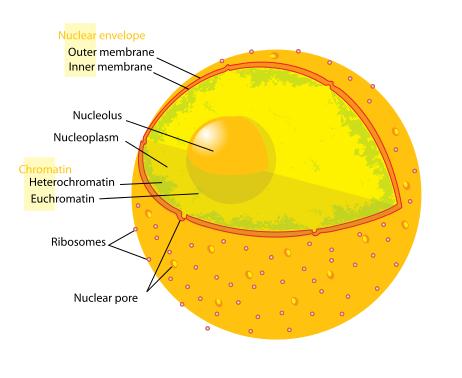The nucleus is perhaps the most important structure inside animal and plant cells. It is the main control center of the cell and acts like the brain of the cell. Only eukaryotic cells have a nucleus. In fact, the definition of a eukaryotic cell is that it contains a nucleus while a prokaryotic cell is defined as having no nucleus.
Organelle
The nucleus is an organelle inside the cell. This means it has a specific function and is surrounded by a membrane that protects it from the rest of the cell. It floats in the cytoplasm (the fluid inside the cell).
How many nuclei are in a cell?
Most cells have only one nucleus. It would be confusing to have two brains! However, some cells develop with more than one nucleus. It’s not common, but it happens.
Nucleus Structure
- Nuclear envelope – The nuclear envelope is made up of two distinct layers of membranes: the outer membrane and the inner membrane. The envelope protects the nucleus from the rest of the cytoplasm and prevents special molecules of the nucleus from escaping.
- Nucleolus – The nucleus is a large structure in the nucleus that mainly produces ribosomes and RNA.
- Nucleoplasm – Nucleoplasm is the fluid that fills the inside of the nucleus.
- Chromatin – Chromatin is made up of proteins and DNA. They organize themselves into chromosomes before cell division.
- Pore – Pores are small channels through the nuclear envelope. They allow the passage of smaller molecules, such as messenger RNA molecules, but keep larger DNA molecules inside the nucleus.
- Ribosome – Ribosomes are made inside the nucleus and then sent outside the nucleus to make proteins.

Genetic Information
The most important function of the nucleus is to store the genetic information of the cell in the form of DNA. DNA contains instructions for how the cell should function. DNA stands for deoxyribonucleic acid. DNA molecules are organized into special structures called chromosomes. Parts of DNA are called genes and contain genetic information such as eye color and size. You can go here to learn more about DNA and Chromosomes.
Other Functions
- RNA – In addition to DNA, the nucleus contains another type of nucleic acid called RNA (ribonucleic acid).
- RNA plays an important role in the production of proteins known as protein synthesis or translation.
- DNA Replication – The nucleus can make exact copies of its DNA.
- Transcription – The nucleus produces RNA that can be used to carry messages and copy instructions from DNA.
- Translation – RNA is used to configure amino acids into special proteins for use in the cell.
Interesting Facts about the Cell Nucleus
- The nucleus is the first cell organelle discovered by scientists.
- It usually occupies about 10% of the cell volume.
- Each human cell contains about 6 feet of DNA that is tightly packed but highly organized with proteins.
- The nuclear envelope breaks down during cell division, but forms again after the two cells separate.
- Some scientists believe that the nucleolus plays an important role in cellular aging. The cell nucleus takes its name from the Scottish botanist Robert Brown.

